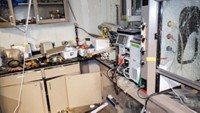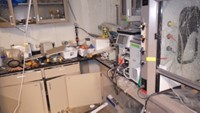Advertisement
Grab your lab coat. Let's get started
Welcome!
Welcome!
Create an account below to get 6 C&EN articles per month, receive newsletters and more - all free.
It seems this is your first time logging in online. Please enter the following information to continue.
As an ACS member you automatically get access to this site. All we need is few more details to create your reading experience.
Not you? Sign in with a different account.
Not you? Sign in with a different account.
ERROR 1
ERROR 1
ERROR 2
ERROR 2
ERROR 2
ERROR 2
ERROR 2
Password and Confirm password must match.
If you have an ACS member number, please enter it here so we can link this account to your membership. (optional)
ERROR 2
ACS values your privacy. By submitting your information, you are gaining access to C&EN and subscribing to our weekly newsletter. We use the information you provide to make your reading experience better, and we will never sell your data to third party members.
Climate Change
Reactions: Carbon capture from fermentation processes, and safety in C&EN images
March 25, 2024
| A version of this story appeared in
Volume 102, Issue 9
Letters to the editor
Carbon capture from fermentation processes
Two items in the Feb. 12/19, 2024, issue (the letter “Direct Air Capture,” page 5, and the article “Researchers Caution about Reliance on CO2 Removal,”page 17) discuss some economic and sustainability issues related to the reduction of atmospheric carbon dioxide, which is needed to achieve goals on mitigating global warming. Ultimately, multiple approaches will be required. One approach that I hear little about is the capture and reuse of CO2 generated as a by-product of fermentation processes, including the anaerobic digestion of food and sewage waste. The CO2 is derived from various forms of biomass and generated in enclosed spaces at higher concentrations than air, which should make capture more efficient. I believe that the CO2 produced is typically just vented into the air.
Anaerobic digestion facilities are already separating the digestion-generated CO2 from the biogas before the methane is used to generate renewable electricity. More CO2 could be captured from the flue gas. The Quantum Biopower anaerobic digestion facility where I send my food waste processes about 36,000 metric tons (t) of material annually and has reported that it avoids roughly 4,500 t of CO2 emissions annually. I’ve read that anaerobic digestion of sewage sludge at Boston’s regional sewage treatment facility on Deer Island produces about 5 million ft3 (about 142,000 m3) of biogas daily, which I calculate as resulting in over 10 times as much CO2(from the biogas and burning of methane) as the total CO2 produced from the Quantum Biopower facility. Scaling such facilities widely and capturing and using the generated CO2 in the production of, for example, aviation and other transportation fuels could significantly contribute to reducing fossil CO2 emissions and eventually to reducing atmospheric CO2 levels.
William C. Horne
Branford, Connecticut
Safety in images
I read with interest the article by Geoffrey Kamadi “C&EN Talks with Stephen Cochrane, Antibiotics Researcher”(C&EN, Feb. 12/19, 2024, page 26). It looks like Dr. Cochrane is in a lab without his personal protective equipment (PPE). I recommend that future publications respect lab safety protocols by either showing people in lab with their PPE or adding a qualifying statement that all chemicals, etc. have been removed—as is done in the current American Chemical Society RAMP (recognize hazards, assess risks, minimize risks, and prepare for emergencies) lab safety videos. C&EN should set the correct example. We faculty have enough trouble getting students to comply with lab safety regulations. C&EN’s support is requested. Thank you!
Ruth Ann Cook Murphy
Austin, Texas




Join the conversation
Contact the reporter
Submit a Letter to the Editor for publication
Engage with us on Twitter